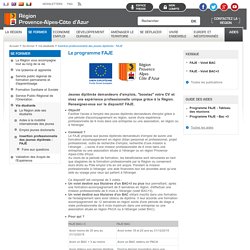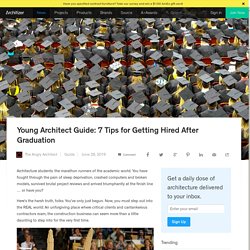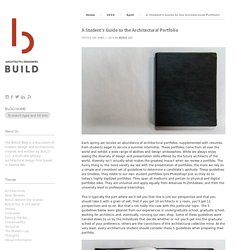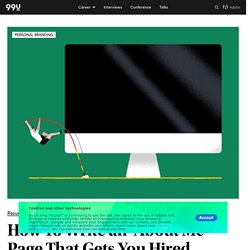

Insertion professionnelle des jeunes diplômés : FAJE. Jeunes diplômés demandeurs d'emplois, "boostez" votre CV et vivez une expérience professionnelle unique grâce à la Région.

Renseignez-vous sur le dispositif FAJE. Objectif Faciliter l'accès à l'emploi des jeunes diplômés demandeurs d'emploi grâce à une période d'accompagnement en région, suivie d'une expérience professionnelle de 6 mois dans une entreprise ou une association, en région ou à l'étranger. Comment ? Le FAJE propose aux jeunes diplômés demandeurs d’emploi de suivre une formation accompagnement en région (bilan personnel et professionnel, projet professionnel, outils de recherche d’emploi, recherche d’une mission à l’étranger …) suivie d’une mission professionnelle de 6 mois dans une entreprise ou une association située à l’étranger ou en région Provence-Alpes-Côte d'Azur.Au cours de la période de formation, les bénéficiaires sont rémunérés en tant que stagiaires de la formation professionnelle par la Région ou conservent leurs droits au Pôle emploi s’ils en ont acquis.
Young Architect Guide: 7 Tips for Getting Hired After Graduation. Architecture students: the marathon runners of the academic world.

You have fought through the pain of sleep deprivation, crashed computers and broken models, survived brutal project reviews and arrived triumphantly at the finish line … or have you? Here’s the harsh truth, folks: You’ve only just begun. Now, you must step out into the REAL world: An unforgiving place where critical clients and cantankerous contractors roam, the construction business can seem more than a little daunting to step into for the very first time. Image via University of Notre Dame So, how can you give yourself the best chance of securing a job to gain the experience that will enable you to take all of that in stride? 1. It goes without saying that your curriculum vitae will play a crucial role in bagging you your first job after graduation — it will be a major influencing factor for firms deciding on who they might employ this summer.
Image via Yale School of Architecture.
NETWORKING. A Student’s Guide to the Architectural Portfolio. Each spring we receive an abundance of architectural portfolios, supplemented with resumés, from students eager to secure a summer internship.

These portfolios come from all over the world and exhibit a wide range of abilities and design philosophies. While we always enjoy seeing the diversity of design and presentation skills offered by the future architects of the world, diversity isn’t actually what makes the greatest impact when we review a portfolio. The funny thing is, the more variety we see with the presentation of portfolios, the more we rely on a simple and consistent set of guidelines to determine a candidate’s aptitude. These guidelines are timeless, they relate to our own student portfolios (pre-Photoshop) just as they do to today’s highly digitized portfolios. They span all mediums and pertain to physical and digital portfolios alike. 1.
For online presentations, we like the Squarespace templates because they allow for simple navigation and full screen images. How to *Really* Get Hired at an Architecture Firm (Part II) We received an interesting email the other day.

A good friend of ours was looking for a hard working, dedicated young architect to provide some horse-power and design savvy at his architecture practice. He knows we get a ton of resumes and was wondering if we could forward a few of the best candidates his way. Glad to, we said, and we got to work looking through our resume file. Our current file is thick to the extent that it’s a bit daunting. The good news is that it indicates a wealth of talent around us. 1. . + A one page cover letter with a brief intro (a paragraph or two) with a bit of humor thrown in for good measure. . + A one page resume with the relevant information: education, professional experience, accreditations. . + A couple of pages of your best work. Tip: When we get physical resumes and portfolios in the mail we tend to hang onto them more often (as opposed to emails). 2.
Tip: Honor an employer’s time by not making them hunt for this information. 3. Cheers from Team BUILD. How To Write an “About Me” Page That Gets You Hired. About pages are hard.

You have one page to summarize who you are, what you do, and how you’re different in a clear, concise, and confident way. No big deal! Just tell us why you matter in two to five paragraphs, without bragging. Honestly, I don’t know anyone who enjoys this process. Even if you’re comfortable writing about yourself, it’s hard to know where to start or what to leave out. Over the past 10 years, I’ve been fortunate enough to help all sorts of people get their websites into shape. Write to your dream audience.Highlight the kind of work you want to be doing.Tell the truth in your own voice.Read it aloud to make sure it sounds like you.Treat it as a draft.